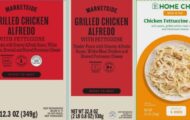Keep spring holiday meals safe with tips from the USDA. This year, the three major holidays of Easter, Eid, and Passover are all happening in early spring.

USDA Under Secretary for Food Safety Dr. Emilio Esteban said in a statement, “The holiday season is a special time to gather with friends and family and enjoy traditional meals, Whether you’re celebrating your Easter dinner with ham, Eid lunch with lamb, or Seder meal with brisket, remember to keep food safety at the forefront.”
Food safety is especially important when you have people with varied health statuses and ages at your spring holiday meals table, because some of those people are more susceptible to serious complications from food poisoning. In addition, some foods must be prepared early, which extends the time for possible contamination.
First of all, keep your hands clean, before, during and after food prep. Handwashing is the first step to avoid foodborne illness. Second, prevent cross-contamination between raw meats, eggs, poultry, and seafood and foods that are eaten uncooked. Clean and sanitize any areas where these raw meats have been before, during, and after cooking.
Third, thaw meat and poultry safely. Never thaw these foods at room temperature; they should be thawed in the refrigerator, which may take days, depending on the size of the product. You can also thaw these foods in cold water or in the microwave. If you thaw the foods in the microwave they must be cooked immediately.
Fourth, always cook foods to a safe final internal temperature. Fish should be cooked to 145°F; beef, pork, lamb, and veal steaks, chops, and roasts to 145°F with a three minute stand time; and hams, to 145°F. Ground meats, including beef, pork, lamb and veal must be cooked to 160°F, along with egg dishes. And all poultry, whether ground or whole, must be cooked to 165°F.
Fifth, keep hot foods hot and cold foods cold. Use warming trays and ice to keep food out of the danger zone of 40°F to 140°F. Make sure that all perishable food is refrigerated after it has been out of the oven or fridge for two hours.
And finally, use or freeze leftovers within four days. Divide leftovers into smaller portions and refrigerate or freeze them in shallow containers. Make sure that you reheat all leftovers to 165°F before serving. And check all temperatures with a reliable and accurate food thermometer.




